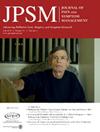Understanding and Predicting End-of-Life Care Preferences Among Urban-Dwelling Older Adults in China
IF 3.5
2区 医学
Q2 CLINICAL NEUROLOGY
引用次数: 0
Abstract
Context
Understanding older adults’ preferences for end-of-life care (EoLC) is vital for respecting their wishes and informing effective service planning and policy development. Previous research has examined factors influencing different dimensions of EoLC preferences separately, but few studies have explored these dimensions as interconnected patterns and viewed older adults as heterogeneous using a person-centered approach.
Objectives
This study aims to: 1) identify heterogeneous latent patterns across seven dimensions of EoLC preferences among Chinese older adults; 2) describe and explain these patterns; and 3) predict membership within these patterns.
Methods
: Survey data from 646 urban-dwelling older adults aged 60 and above across 26 provincial-level administrative divisions in Mainland China were analyzed. EoLC preferences regarding willingness to know diagnosis, willingness to know prognosis, decision-maker, treatment goals, place of care, caregiver, and setting advance directives were assessed alongside demographics, resources, knowledge and attitudes, and caregiving/bereavement experiences. Latent class analysis (LCA), 3-step regressions, and Catboost machine learning models were employed to identify subgroups, examine between-group differences, and predict subgroup membership, respectively.
Results
LCA identified three latent patterns: “low self-determination, quality-goal, family-oriented care” (9.1%), “high self-determination, quality-goal, family-oriented care” (54.0%), and “high self-determination, quantity-goal, professional-oriented care” (36.9%). Significant between-group differences were found in education, marital status, living arrangements, family income, social support, EoLC knowledge, general trust, and professional-patient trust. Machine learning models revealed that high general trust predicts membership in the high self-determination, quality-goal, family-oriented care group, while low filial piety expectations predict membership in the high self-determination, quantity-goal, professional-oriented care group.
Conclusion
Among Chinese older adults, three EoLC preference patterns were found, which were characterized by low family connections, low trust in professionals combined with adequate resources, and extensive knowledge, respectively. High general trust and low filial piety expectations were key predictors for two of the three patterns.
中国城市老年人临终关怀偏好的理解与预测
背景:了解老年人对临终关怀(EoLC)的偏好对于尊重他们的意愿和为有效的服务规划和政策制定提供信息至关重要。先前的研究分别考察了影响EoLC偏好不同维度的因素,但很少有研究将这些维度作为相互关联的模式进行探索,并使用以人为中心的方法将老年人视为异质性。目的:本研究旨在:1)识别中国老年人临终关怀偏好在七个维度上的异质性潜在模式;2)描述和解释这些模式;3)预测这些模式中的成员。方法:对中国大陆26个省级行政区的646名60岁及以上城市老年人的调查数据进行分析。评估EoLC对了解诊断的意愿、了解预后的意愿、决策者、治疗目标、护理地点、护理人员和制定预先指示的偏好,以及人口统计学、资源、知识和态度以及护理/丧亲经历。使用潜类分析(LCA)、三步回归和Catboost机器学习模型分别识别亚组、检查组间差异和预测亚组成员。结果:LCA识别出“低自我决定、质量目标、家庭导向护理”(9.1%)、“高自我决定、质量目标、家庭导向护理”(54.0%)和“高自我决定、数量目标、专业导向护理”(36.9%)3种潜在模式。在教育程度、婚姻状况、生活安排、家庭收入、社会支持、EoLC知识、一般信任和医患信任方面,组间存在显著差异。机器学习模型显示,高总体信任预示着高自决、质量目标、以家庭为导向的护理组的成员,而低孝道期望预示着高自决、数量目标、以专业为导向的护理组的成员。结论:中国老年人存在三种EoLC偏好模式,分别表现为低家庭关系、低资源信任和广博知识。高普遍信任和低孝道期望是三种模式中两种模式的关键预测因子。
本文章由计算机程序翻译,如有差异,请以英文原文为准。
求助全文
约1分钟内获得全文
求助全文
来源期刊
CiteScore
8.90
自引率
6.40%
发文量
821
审稿时长
26 days
期刊介绍:
The Journal of Pain and Symptom Management is an internationally respected, peer-reviewed journal and serves an interdisciplinary audience of professionals by providing a forum for the publication of the latest clinical research and best practices related to the relief of illness burden among patients afflicted with serious or life-threatening illness.

 求助内容:
求助内容: 应助结果提醒方式:
应助结果提醒方式:


